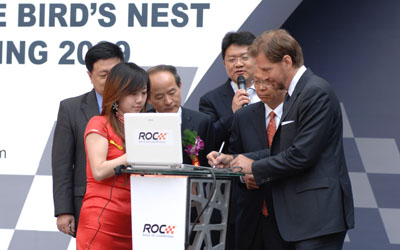SPECIAL REPORT: The Evolution of Marketing and the Rise of Race of Champions
October 20, 2015
In today’s hyper-connected world it’s getting harder to remember what it was like to be alive in the late Eighties.
No internet, online no social media – and the only mobile phones about were only marginally smaller than the phone boxes they would come to replace.
The world of marketing has undergone a complete overhaul since then – with the rise of technology largely dictating the pace.
One event perfectly placed to document the progress is the Race Of Champions (ROC), medicine an annual end-of-season motor sport contest first held in Paris in 1988.
It has come a long way since, visiting venues as diverse as Beijing, Barbados and Bangkok with over 25 successful events.
Next up it’s heading to London’s former Olympic Stadium on November 20-21, bringing a field of driving royalty such as four-time F1 world champion Sebastian Vettel, double MotoGP world champion Jorge Lorenzo, ‘Mr Le Mans’ Tom Kristensen and many more.

Unlike mobile phones, ROC started out much smaller.
Originally the brainchild of IMP (International Media Productions) President Fredrik Johnsson and the most successful ever female rally driver of all time Michèle Mouton, the first Race Of Champions was created to celebrate the 10th anniversary of the first World Rally Drivers Championship, pitting the sport’s greats in identical cars.
This was the end of rallying’s mythical Group B era and competitors included such glorious names as Stig Blomqvist, Ari Vatanen, Walter Röhrl and Hannu Mikkola.
The dangers they faced are shown by the fact that the first ROC was also held in memory of the late Henri Toivonen, who died at the Corsica Rally while leading the world championship in 1986.
It was a different era for marketing too, as ROC president Fredrik Johnsson recalls: “We put up posters all over Paris and distributed them to automobile clubs.
“We networked with journalists to get stories into the major publications like L’Equipe and created media partnerships with France’s main broadcaster TF1 so we’d feature in their programmes.
“But we didn’t get it all right: we printed 10,000 books to celebrate the first ten years of the World Rally Championship as part of some ticket promotion. We’ve still got 5,000 of them in storage…”

In the Nineties the event established a permanent base in Gran Canaria – and it soon turned heads in other series. By the new Millennium, racers included F1’s Fernando Alonso, American NASCAR legends Jeff Gordon and Jimmie Johnson, two-wheeled specialists such as Valentino Rossi and even stunt stars like X-Games legend Travis Pastrana.
They all came to challenge the rally greats for the ‘Champion of Champions’ title, attracted by a knockout tournament still independently run by Johnsson’s small team.
Suddenly ROC’s Gran Canaria home didn’t seem big enough to hold them all. Then came a change of strategy in 2004, when the event returned to Paris at a unique venue for motor sport: the Stade de France, the stage for football’s World Cup Final six years earlier.
Within such an enclosed environment the sheer spectacle and the noise of the engines reached a new crescendo as seven-time F1 world champion Michael Schumacher battled the man who would go on to become rallying’s greatest: Sébastien Loeb. It’s been onwards and upwards ever since.
“Paris 2004 was a huge step for us,” adds Johnsson. “Being in a big stadium where people were used to coming for football and concerts brought us even closer to the fans, who could see every moment of the action from every seat. We were also one of the first events to start selling tickets online – which is now where we sell most of our tickets.
“Since then our focus has shifted more and more towards digital. Social media is the big game changer, where you can interact with fans all over the world on a continuous basis, and get feedback immediately. Today’s technology lets us understand our target group much better and learn what type of marketing actually delivers instant results in terms of ticket sales.

“But there’s still room for traditional advertising, even if that has changed too. We still do TV commercials but when it comes to outdoor advertising that is now mostly digital, which opens up new opportunities so we can send out an evolving message.”
An evolving message in an evolving world: ahead of next month’s Race Of Champions in London the digital blitz is ongoing. But you can also keep your eyes out for ads on the capital’s buses and taxis, plus its daily newspapers. Even in a digital world, some old ways do still pay off…
Further Information
Race Of Champions 20 -21 November 2015
The former Olympic Stadium at Queen Elizabeth Olympic Park, London.
Tickets for ROC 2015 are available now from www.ticketmaster.co.uk/roc with prices starting from just £24 and children half price.
For more information on the Race Of Champions, from full driver profiles to a more detailed history of the event plus the chance to download high-resolution images, please visit www.raceofchampions.com.
You can also sign up for Race Of Champions on Facebook and follow us on Twitter via @raceofchampions and the hashtag #ROCLondon.
{jcomments on}



